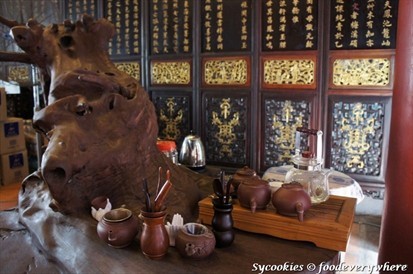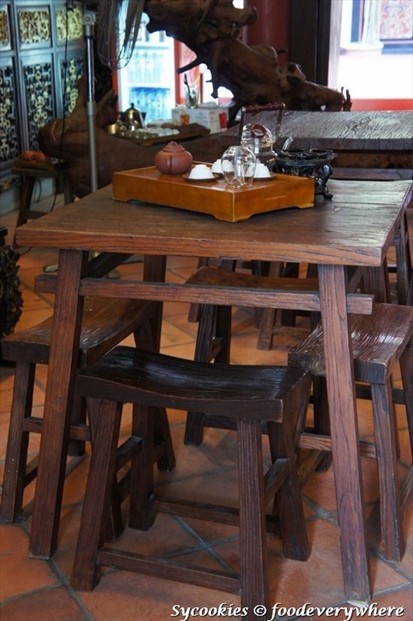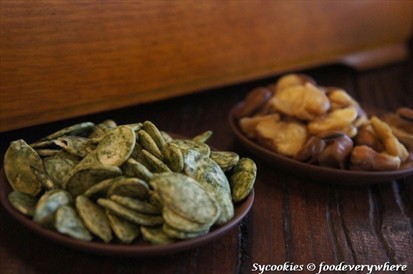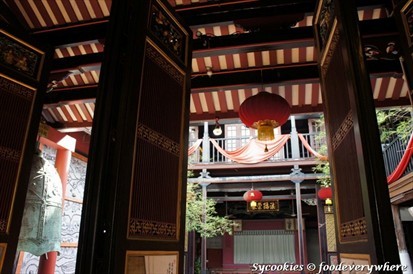Showing 16 to 20 of 702 Reviews in Malaysia | |
Tea is an indispensable part of the life of a Chinese. A Chinese saying identifies the seven basic daily necessities as fuel, rice, oil, salt, soy sauce, vinegar, and tea. The custom of drinking tea is deeply ingrained in almost every Chinese, and has been for over a thousand years (Jing Tea Shop, 2009). The Chinese were the first to discover tea. Wherever Chinese go, the custom of drinking tea follows. Back when I was spending enough time in Hong Kong China, almost every morning in any parks would be the spot for retired elderly, gathering leisurely around a small pot of tea. Tea is made from the young, tender leaves of the tea tree. The differences among the many kinds of tea available are based on the particular methods used to process the leaves. And believe it or not, all tea comes from the same plant; the Camellia sinensis. There are a great variety of teas – over 3000, in fact. All of them have one thing in common: they are made from the leaves or buds of some variant of Camellia Senensis. The key to the whole process is the roasting and fermentation. Through fermentation, the originally deep green leaves become either reddish to brown in color. The longer the fermentation would result in the darker colour of tea leaves. Depending on the length of the roasting and degree of fermentation, the fragrance can range from floral, to fruity, to malty (Parkinson. R, 2012). Historical records reveal that Ming Dynasty’s Admiral Cheng Ho (Zheng He) visited Melaka (Malacca) at least five times during his famous seven voyages to the Western Ocean (Southeast Asia, Indian Ocean, Middle East and Africa). Some claims that he set up a huge warehouse complex along the northern side of the Melaka River. However, many others do not agree. (http://chengho.org, 2012). Together with Cheng Ho Cultural Museum, this Chinese teahouse is a tranquil break free from the crowd and noise on Jonker Street in Melaka. Situated in a historic building, this tea house is preserves the heritage design of atmospheric space with high timber ceilings with a central courtyard and rather airy space. The linings of its walls are wooden panels inscribed with Chinese calligraphy as well as beautiful Chinese painted carvings. Apart from the amazing ambience, the tea house also allow visitors to understand the ancient art of tea ceremony for RM 30 per table for 4 person, and watch the puppet show about the Admiral Cheng Ho’s voyages (1371-1433). This place is really huge with quite a bit of interesting interior and furniture to be appreciated. There are many antiques and furniture that has been very well preserved.Served with light nut and seed bites, this tea break is perfectly amazing for some quality bonding time. At the same time, enjoy and learn a little bit of the art of tea ceremony from the tea connoisseur who will share the Chinese art of tea tasting. The proprietress serves us well and it was indeed lovely to have that quick chat with her. Here is the demonstration of tea ceremony and how we should be savouring tea. A common mistake people often make is to steep tea leaves for a long time to achieve the thick extract out of it. Other Ratings:Taste 4 | Environment 5 | Service 5 | Clean 4 | Value for Money 3 Recommend 0 |
Lately, I have been posting quite a bit of post on the Satay Celup. When mentioned Satay Celup, the first place that comes to anyone’s mind would be the historical city of Malacca. The famous Capitol Satay Celup has inevitably craved its status in everyone’s heart. In fact, there are so much Satay Celup in Malacca, there is even the Halal Satay Celup . Folks in Klang Valley would no longer drive all the way to Malacca anymore for some awesome Satay Celup. The Royal Satay Celup is one place with no hassle to get your car parked and enjoy quite some fresh skewers. Located in Damansara Uptown, this place is not difficult to be located. And with the vibrant sign board despite the half a shop lot’s space to dine, you cannot not see the shop. The layout of the shop is pretty simple and clean. it doesn’t have too many tables but what really amazes me would be the hygiene and the cleanliness of this place. The service was amazing as well and most importantly the pot of satay sauce weren’t recycled. Every pot is new when diners are seated. Fan of Satay Celup would know this. The sauce boils real fast and you might not want to be a victim to those boiling sauce. Here in Royal Satay Celup, the pot is uniquely designed to a half half so kids might wanna cook their skewers in the boiling water instead. Another purpose is to prevent the thick peanut sauce from being burnt and alas sticking to the bottom of the pot. It is pretty obvious that cleanliness is quite some priority here as you can see, the table and the surrounding of the boiling pot were amazingly sparkling. Here is some glimpse of what they have in their fridge. That might be another thing that a microbiologist would pay extra attention to. I really like that fact that those skewers are kept in closed fridge at all time. The skewers are all priced at RM 0.80 each, similar to the ones in Malacca. The plates cost RM 2 for yellow plates and RM 3 for those blue plates. Unlike what’s commonly served along with Satay Celup, white bread is replaced by some Deep Fried bun. As for those thirst quencher which is a must when having Satay Celup, they offer only a few. Namely their Leong Sui, and some canned soft drinks. Cendol Gula Melaka is also served here for RM 3. I didn’t try that since I was there for supper. How can I possibly afford Cendol Gula Melaka after those delicious skewers? We simply just went for their Leong Sui. Other Ratings:Taste 4 | Environment 4 | Service 4 | Clean 5 | Value for Money 4 Recommend 0 |
If you have been following my Facebook Page , then you might have already come across some photos of those tips and food facts. The actual fact is that all tea types are from a same plant called the Camellia Sinensis. The herbal tea on the other hand do not consist any part of the tea plant. The Chinese herbal tea, constantly known as medicinal herbal tea is a kind of tea made purely from Chinese medicinal herbs in Guangdong China. Since they don’t contain any part of the tea plant, I would say it is more of a tisane rather than actual tea. Because tisane is a general term for any non-caffeinated beverage made from the infusion or decoction of herbs or any spice like plant material, the herbal tea (also known as leong char) is better categorized as the tisane than tea. According to the daily mail (2013), Herbal teas are all the rage for the many medicinal qualities they are supposed to possess. It’s claimed they can help with everything from easing a cold and indigestion to fighting infection and nausea.But when choosing a herbal tea remedy, make sure you pick the right one. While fruit flavoured teas – such as rosehip, apple and orange – tend to be delicious, they are developed for their flavouring more than anything else.Herbal teas on the other hand, such as thyme, peppermint and ginger have greater therapeutic virtues. The Kwong Woh Tong originates from China and slowly expending their business to Hong Kong, Malaysia, and Singapore. The outlets grow rapidly upon their arrival in Malaysia. Of which most are allocated in major shopping malls. In the older days, the herbal tea is something you purchase near the door step of traditional medicinal shop. Where else today, shops like this are getting so much lesser by popular demand in most places. Here in Koong Woh Tong, there are two types of traditional herbal tea to choose from. One that is slightly bitter called the Wong Lou Kat and one that tasted a bit flowerish called the Five Flower Herbal Tea. I really like the first one. When drinking this, it is normally served with plum candy just to relief the bitterness from your palate. I like it even without it. Also available is their remedy medicinal powder to relief flu, cough, heat and or sore throat, which would be added into the bitter tea when consume. Koong Woh Tong not only specializes in herbal tea but also the herbal jelly commonly known as the Guai Lin Kou. Its beneficial herbal jelly is made from more than twenty Chinese herbs which we believe it not only helps cooling down our inner body but good for our skin too. It is normally served with a pot of honey just so you can add it in to adjust the taste of this cooling jelly. One can easily identify a Koong Woh Tong outlet when you see this huge gold pot. You would never miss this and when you see this, you would know that you are at the right place. Recommended Dish(es):
herbal tea Other Ratings:Taste 5 | Environment 3 | Service 3 | Clean 4 | Value for Money 3Recommend 0 |
The layout is really neat and clean, with tidy table settings as well as a free flow of healthy choices of steamboat or in this case, the shabu shabu ingredients. The healthy bar isn’t impressively filled with many varieties, but the choices of ingredients clearly skewed a little towards more vegetation and fungi instead of processed meats.They have friendly choices which are suitable for the entire family. There is lots of vegetables, assorted mushrooms, tofu, seafood tofu, and cheese stuffed tofu fish, carrots, pumpkin, taro, etc. This place does not serve pork, so pork lovers might be a little disappointed with no pork. However, the other free flow of meat slices are beef, lamb and chicken. Solid meat for the balance and healthy combination of diet, provided consumed at the right portion of course. There are four types of soup of which we select two from Miso, Sukiyaki, Kimuchi and Shabu shabu. The kimuchi doesn’t appeal at the beginning, but towards the end of the meal, it simply gets better and better. The right way to eat and savour the meal is printed clearly so study while you dine and you’ll probably learn some new ways of enjoyment in this. Things like how to enhance the sweetness in your soup, as well as the sequence to eating each ingredient and how to make the perfect dipping sauces And help yourself with the kimchi and sushi as appetizers while waiting for the soup to come to boil. The kimchi was not great though. And I wouldn’t pay much attention to the sushi as they weren’t really impressive either. Nevertheless, they come in handy if you are starving in between cooking time. Lastly, the free flow dessert is unlike the usual steamboat buffet where there are more than few flavours. Here is only the green tea or chocolate soft ice cream with some topping choices like chocopops and nata de coco. There is option of honey cone to go with this as well. I must say that the choices are really few for a buffet in this restaurant, but the entire meal right up to the dessert was satisfying and delectable. The price per pax varies for lunch and dinner. Lunch would cost you RM 29.80++ where else dinner is RM 33.80 for adults. Children from 5 to 12 years old would eat at 50% off adult prices and children below 5 years old eat for free. There are ala carte dishes as well, but I reckon the steamboat buffet is sufficient for a good meal. Other Ratings:Taste 5 | Environment 4 | Service 4 | Clean 3 | Value for Money 2 Recommend 0 |
Upon entering, it is almost immediate to tone yourself and easily blend into the cozy and comforting lighting in the restaurant. And of course, the warm welcoming greeting by PAHTIMAH, at the doorway. The dishes are all heart warming and the platters are something to be bragged. The platter that was very enjoyable that night was the Kembong Fish Platter that is common to be found on the menu of most Thai restaurant, be it the authentic ones or the fusion ones. It is a very simple dish consisting of mainly very natural ingredient in it with no addition of heavy spices and flavouring. There is the grrens, which most might not like it as they are somewhat raw. And some fried brinjal and kembong fish which again might not have been the favourite fish to most people out there. the kembong fish itself is flavourful and many find that unacceptably fishy. However, this dish works its own magic with this combination as well as the most important element to sparkle the taste bud, the chili sauce. Strong belancan and strong chili making this my favourite sauce for the night. I thought it was another wonderful dish for sharing at the price of R M18. We were served two fishes both I find it awesome with the flavours if done correctly. The first is the Thai Style Steamed Fish. Don’t expect them to top the freshness in the seafood, and yet they also did try hard with the flavour of the dish.The ingredients and spices on this fish is flooding the hot metal fish shaped plat and the gravy didn’t quite meet up to the usual Thai style that is really rich and tangy spicy. Follow by the yummy Golden Orchid Special Fried Chicken at RM 18 which is delectably great to go in a meal of dishes and rice. Once again, this is nothing too Thai or rather it has already very much localized to our local palate. Nevertheless it was still good. The chicken was amazingly marinated so it was really flavourful. The dishes were not spicy at all, despite to supposedly be Thai dishes, which commonly is well known to be spicy. This also applies to the Paku Pakis which is definitely my favourite. Thai or no Thai, I love this one. Here in the Golden Orchid, the vegetable which belong to the fern leaf family, is done stir fried with sambal belacan The vegetable is sweet and crunchy at the same time pleasantly tender because only young stalks were use. Thumbs up for that!! Thai Fish Cake serves at RM 14 and it was the least favourite of mine so far. The texture was really rough and unpleasantly coarse in texture. Not the best I’ve had. Good thing the Thai Style Omelette manage to redeem their reputation with the very fluff and light texture as well as superb wok heat to ensure the perfect crisp on the outside and fluff on the inside omellete. Must be lots of oil there, but it was awesome! It was priced averagely at RM 15. Candied Tapioca which sells at RM 4.80, but this one is nothing too impressive. I would definitely prefer the texture to be slightly softer and more flavourful within the tapioca itself. The dishes are all fairly priced and very decent for family meals. The flavours are very mild for Thai flavours but great with the oriental touch. Recommended Dish(es):
Paku pakis Other Ratings:Taste 4 | Environment 4 | Service 5 | Clean 4 | Value for Money 4Recommend 0 |
|


![]()




![]()
![]()









 Cry
Cry  Editor's Choice Overall Score
Editor's Choice Overall Score  Full View |
Full View | 




